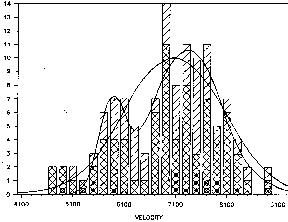


6.3. Velocity Segregation
Different galaxies in Coma have different velocity distributions. This was first noticed by Hawkins [65] who pointed out that galaxies in the Coma centre have a lower mean velocity than galaxies at the edge. However, the value he quoted for the central galaxies (6254 km/s) was very low, and has never been confirmed since.
The first firm result on the velocity segregation in Coma was obtained by
Rood et al. These authors noticed that the five brightest
galaxies (mp < 15.0) of the Coma core have a very low
velocity dispersion,
 v = 231 km/s. Such
an evidence was first confirmed by Struble
[127]
and more recently by Mellier et al. Struble considered two possible
explanations to this effect: (i) the existence of a subcluster in the Coma
core, and (ii) the result of dynamical friction (see also
Section 7.2).
v = 231 km/s. Such
an evidence was first confirmed by Struble
[127]
and more recently by Mellier et al. Struble considered two possible
explanations to this effect: (i) the existence of a subcluster in the Coma
core, and (ii) the result of dynamical friction (see also
Section 7.2).
In the early 70's, Tifft and
des Forêts & Schneider
[35] noted
that Coma ellipticals have a different mean velocity from non-ellipticals.
Ten years after, Kent & Gunn showed that
 v increases along
the Hubble
sequence, from ellipticals to S0s to spirals. This was recently confirmed in
the works of Andreon
[8],
Biviano et al.
[16],
and Colless & Dunn. Zabludoff & Franx
[161]
compared the whole distributions (not only their
moments) of different morphological types, and found that
the velocity distributions of ellipticals and spirals are different.
v increases along
the Hubble
sequence, from ellipticals to S0s to spirals. This was recently confirmed in
the works of Andreon
[8],
Biviano et al.
[16],
and Colless & Dunn. Zabludoff & Franx
[161]
compared the whole distributions (not only their
moments) of different morphological types, and found that
the velocity distributions of ellipticals and spirals are different.
There is a general agreement in interpreting these results as evidence that the blue/star-forming galaxies have not yet reached virial equilibrium, and are still infalling into the cluster (some of them possibly for the first time).

|
Figure 12. Histogram of velocities (in km/s) within 1o of the centre of Coma (shaded) and within 0.5o of Coma (double shaded); strongly HI-deficient galaxies (filled circles), and moderate or null HI-deficient galaxies (open circles), are shown. Curves represent Gaussian fittings to the data - from Gavazzi. |
What remains possibly unexplained is the double-peaked velocity distribution characteristic of many populations of Coma galaxies (see Fig. 12):
Of the two peaks, one is centered at ~ 7500 km/s (close to the mean velocity of the SW group, see Section 7.1), and the other is centered at ~ 5500 km/s, while the cluster mean velocity is ~ 6900 km/s. Subclustering would seem the most obvious explanation for this complex velocity distribution, yet galaxies with velocities close to these peaks are not spatially subclustered (see also Gerbal, these proceedings).